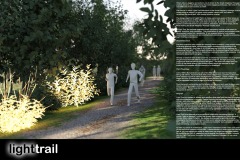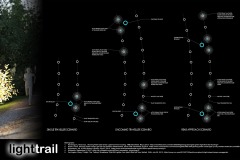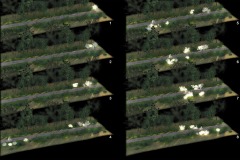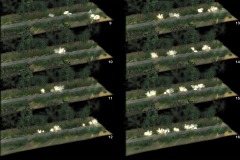In this winning entry from the 2013 Young Architect Design Studio Competition, Light Trail covers bioluminescence, plant physiology, and place creation with minimal physical impact to the environment. Comments from the jury included:
Innovative use of current day scientific experimentation to solve a place making challenge. Incredibly creative way to use nature to have it interact with us and effect the way we understand our interactions with it and with each other. Simple compelling visualization and use of diagrams. Humble and effective proposition.

Light Trail
Hikers, bikers, joggers, and walkers are all drawn to the Great Allegheny Passage to explore, observe, and reflect along the trail’s engaging landscape. But what if the trail reflected on the travelers as well?
The manner in which Light Trail intervenes in the Great Allegheny Passage is not by constructing an object in a space which people interact with, but rather it re-defines the place itself with minimal physical change.
The design objective of Light Trail is to make users more aware of their place on the trail, more aware of their affect and interaction with nature. It also highlights the interactions we have with each other on the trail. It creates an illuminant marker system that reacts to our positions, directions, and relationships, all the while making the Great Allegheny Passage a safer place.
In Light Trail, the trailside vegetation itself becomes a luminaire that reacts to speed, proximity, and orientation. The combination of several technologies under development makes this a possibility. If you suspend disbelief and imagine combining bioluminescence and modified plant physiology, the path to producing Light Trail becomes clearer.
Bioluminescence
The plant scientists who created the Glowing Plants initiative, a new project aimed to develop glowing plants, have already begun crowdsourcing funding on the website Kickstarter. As of May 8, 2013, the team has $280,000 of backing, far surpassing their goal 1. Their project compiles the fluorescent gene from fireflies and prints the DNA into bacteria that act as a vehicle to deliver the sequence. Even the plants descendants will glow.
Already a research team at the University of Cambridge invented a way to brighten the glow from the firefly DNA by recycling the luciferins, the light producing compounds that are spent to produce the glow2. The team even calculated that only 0.02% of the plants energy from photosynthesis would be required for light production to compete with the intensity of a streetlight2.
Plant Physiology
In the 1980’s Marcel Dicke was one of the first to discover plant transduction. Along with others, he proved that when under attack from a predator, a plant will send chemical signals to other plants, known as volatiles3. These volatiles can trigger an array of responses depending upon the plant and the situation. Signals can be repeated from plant to plant in a series as required.
From that point we have learned that plants can perceive and react to many more stimuli, including oxygen, carbon dioxide, magnetic fields, and mechanical perturbation4. Plants have also shown the ability to display rapid electrical responses to stimuli4.
Program
Light Trail is a system of actions and reactions that uses both the plant physiology and bioluminescence in concert. People travelling have glowing vegetation always at their right side, based on their direction of travel as perceived by the plants. As other travelers are approaching, either head-on or quickly from behind, the vegetation transduces another signal to your position. This signal is several steps ahead of your own glowing marker, indicating there is another approaching. This would help with bikes passing walkers or being startled by someone oncoming from an obscured corner.
Light Trail is an alternative to conventional, electricity-consuming lighting. A similar “light on demand” system has already been proposed by Dutch designer Chintan Shah, called Tvilight5. His system is proposed to light city street by streetlights that have activity sensors that would reduce energy consumption by 80%. Light Trail is similar, but the sensors are the plants’ own perception, and the electrical energy consumption is zero.
As with any piece of architecture, Light Trail is intended to make users more aware of the world and systems around them. It demonstrates an awareness that nature has of you, and makes you aware of others how you might not have been before. By modifying the DNA of vegetation and changing the program of what it already can do, Light Trail could illuminate the Great Allegheny Passage in a way never seen before.




